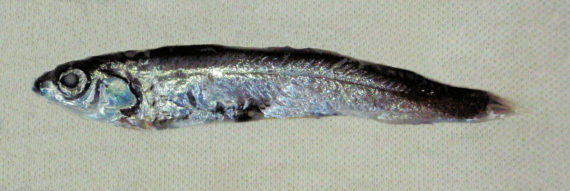Snubnose Blacksmelt, Bathylagoides wesethi
 Snubnose Blacksmelt, Bathylagoides wesethi. Fish collected by H.J. Walker, Jr., Scripps Institute of Oceanography, La Jolla, California, in a deep water trawl net off Point Loma, California, August 2010. Length: 6.5 cm (2.6 inches).
Snubnose Blacksmelt, Bathylagoides wesethi. Fish collected by H.J. Walker, Jr., Scripps Institute of Oceanography, La Jolla, California, in a deep water trawl net off Point Loma, California, August 2010. Length: 6.5 cm (2.6 inches).
The Snubnose Blacksmelt, Bathylagoides wesethi, is a member of the Deep Sea Smelt or Bathylagidae Family, and is known in Mexico as desaire nariz capellane mesopelágico. Globally, there are twenty-two species in the Bathylagidae Family that are in eight genera. There are three species in the Batylagoides Genus two of which are found in Mexican waters of the Pacific Ocean.
The Snubnose Blacksmelt has a slender compressed elongated body that is widest slightly behind the pectoral fin base and taper towards the caudal fin. They are silvery in color and dark brown dorsally with black spots and a black area around their gill openings. Their fins are translucent. Their eyes are disproportionately large and twice the length of the rounded snout. They have a small terminal oblique mouth with a gill opening that reaches halfway up the side of their body. Their anal fin has 13 to 17 rays; their caudal fin is very short with a very narrow base; their dorsal fin is set well behind the mid-point of the body with 10 to 14 rays; their pectoral fins are short, set low on the body, and do not reach the dorsal fin origin. They have 24 to 26 gill rakers. The are covered with scales. Their lateral line is high on the body and extends into the caudal fin.
The Snubnose Blacksmelt is an oceanic mesopelagic species that resides in the Atlantic, Indian, and Pacific Oceans and found at depths between 24 m (80 feet) and 4,268 m (14,000 feet). They reach a maximum of 13.5 cm (5.3 inches) in length. Adults are vertical migrators moving toward the surface at night to feed on small crustaceans and returning to the depths during the day for protection from predation. They provide a valuable food source for all sorts of birds, dolphins, fish, sea lions, and of course the Humboldt Squid. Reproduction is oviparous with planktonic eggs and larvae. The Snubnose Blacksmelt is poorly studied with very limited information available about their lifestyle and behavioral patterns including specific details on age, growth, longevity, movement patterns, diet, habitat use, and reproduction.
The Snubnose Blacksmelt is a resident of Mexican waters of the Pacific Ocean but has a limited distribution being found only along the west coast of Baja.
The Snubnose Blacksmelt is a difficult fish to identify and requires help from a professional ichthyologist for correct identification.
From a conservation perspective the Snubnose Blacksmelt has not been formally evaluated. Due to their small stature, rare and seldom seen by humans are of little interest to most.